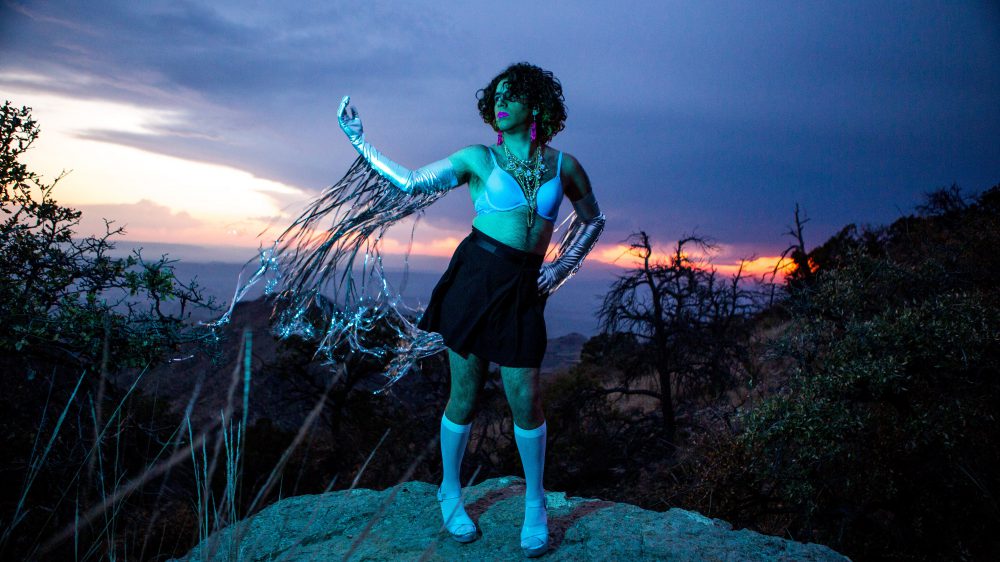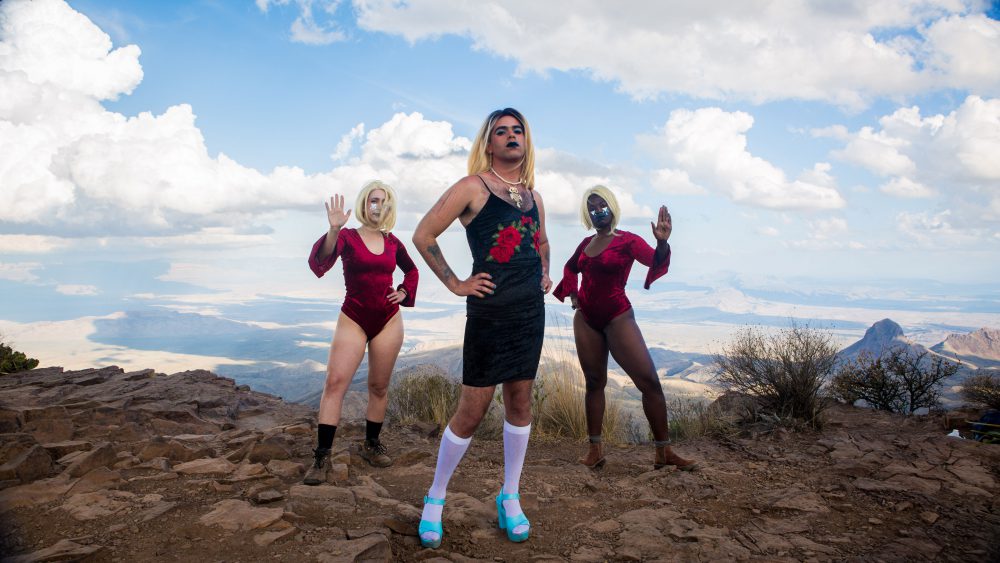Noisy Bottoms, Queer Noise: Lucia Honey’s “The Bottom”
Andy Johnson considers Lucia Honey’s new video opera within the context of queer noise.

A still from Lucia Honey’s The Bottom, 2018. Single-channel video. Courtesy the artist. Photo by Sarrah Danziger.
New Orleans-based artist Lucia Honey’s latest video The Bottom, 2018, a self-described “noise opera,” is a journey into the crumbling excess and generative energy of queer noise. Undoubtedly a play on words, the title refers to both the submissive role in sex and the feeling of being at an emotional low in one’s life. A collaboration with co-directors Chris Berntsen, Sarrah Danziger, and Damien Moreau, the video is a series of songs—by Honey’s musical project Oblivia—and performances set on the streets of Las Vegas, in a Texas national park, and on Lake Pontchartrain in New Orleans. Honey embarks on a trip through inebriation, dissonance, and psychological disintegration. Short clips of the Vegas Strip’s flashing lights and glittering signs fade in and out of one another, a montage reminiscent of many films shot there—think of the twinkling opening credits of Sister Act 2: Back in the Habit (1993). Illustrative of, and arguably a result of, the city’s economy of consumption, spending, and distinctly American indulgence, Honey spins and twirls with a degree of drunken carelessness.
Later, The Bottom finds Honey, along with two backup dancers—artists Marta Rodriguez Maleck and Ashley Teamer—performing atop the mountains of Big Bend, Texas. During that song, entitled “Where’s My Phone?”, from Oblivia’s second album, Martyr Complex, Honey’s performance becomes more rehearsed, yet never loses an overwhelming sense of isolation and incoherence. The song’s lyrics read, “I can’t seem to open new portals of communication.” In the film, all three scream out, but their calls go unheard in the vast landscape around them. Lastly, floating on a large inflatable duck on Lake Pontchartrain in New Orleans, dressed in a yellow rain jacket with yellow gloves on both hands and feet, Honey performs “Desperately Seeking Arrangements.” Furthering her detachment as a castaway, she sings atop the duck. As before in Vegas, the shots slowly fade in and out of one another, inducing a sense of dislocation.
Noise music, characterized by the use of traditionally non-musical sounds in a music setting, dates back to the early 20th century. (Paul Hegarty’s 2007 book Noise/Music: A History traces the genealogy of noise music.) Avant-garde in essence, the genre resists homogeneity and favors a more experimental approach. Queer noise, as a sub-genre, further resists conformity and challenges compulsory heterosexuality, creating space for gender-nonconforming, trans, and non-binary identities within the noise scene. Queer noise is developed around a language of incoherence and illegibility, one that relieves the body from the need to identify. Fittingly, at the beginning of The Bottom, Honey’s synthesized voice states, “In case you were wondering. Yes. It is quite hard being this magic in such a violently didactic world. What a time to be alive.”

A still from Lucia Honey’s The Bottom, 2018. Single-channel video. Courtesy the artist. Photo by Sarrah Danziger.
The soundtrack of The Bottom is a distinct and purposeful cacophony of synthesized voices, electronic blips, 808 beats, and sci-fi inspired sounds. The lyrics to the tracks are understood through the video’s subtitles. The Bottom’s illegibility is an example of the way in which noise music defies the need for order. According to performance and visual artist Eames Armstrong, noise, particularly queer noise, as opposed to mainstream music, “resists social pressure for positive stability and wholeness, a pressure that aims to perpetually reproduce sameness.” Noise troubles coherence, challenges the structures of popular music in favor of something less controlled, and as Armstrong notes, “queers or inverts the binary that privileges clarity.” Honey, through presentation and performance, invites disorder and disidentification, a term coined by José Esteban Muñoz to describe the ways in which marginalized individuals consciously subvert dominant culture as a form of queer worldmaking.
In the opening track of The Bottom, Honey sings “What a time to wish you were dead. But at least rock bottom has a basement girl. Lows so low they become highs.” Armstrong contends that a “negative hope” is often the drive of queer noise and argues that there is hope in negativity because of “its potential to produce and exist in contradiction.” In contradiction to the veiled hope of heteronormativity and the promises of a binary world, a negative hope opens up, in Honey’s words, “a new portal of communication.” Ultimately, nonconformity and instability are built into the infrastructure of queer noise, providing the space for experimentation, improvisation, destruction, and creation. The Bottom doesn’t have a beginning, middle, or end; it’s not built around the legible narrative often sought after in opera. There are no identifiable choruses, bridges, intros, or outros. The end goal is not resolution, but instead a release from the pressure to conform. The Bottom illustrates this letting-go and the pleasures of incoherence, of the noise at the bottom.
Editor's Note
Lucia Honey’s The Bottom, 2018, is available to watch on YouTube.



